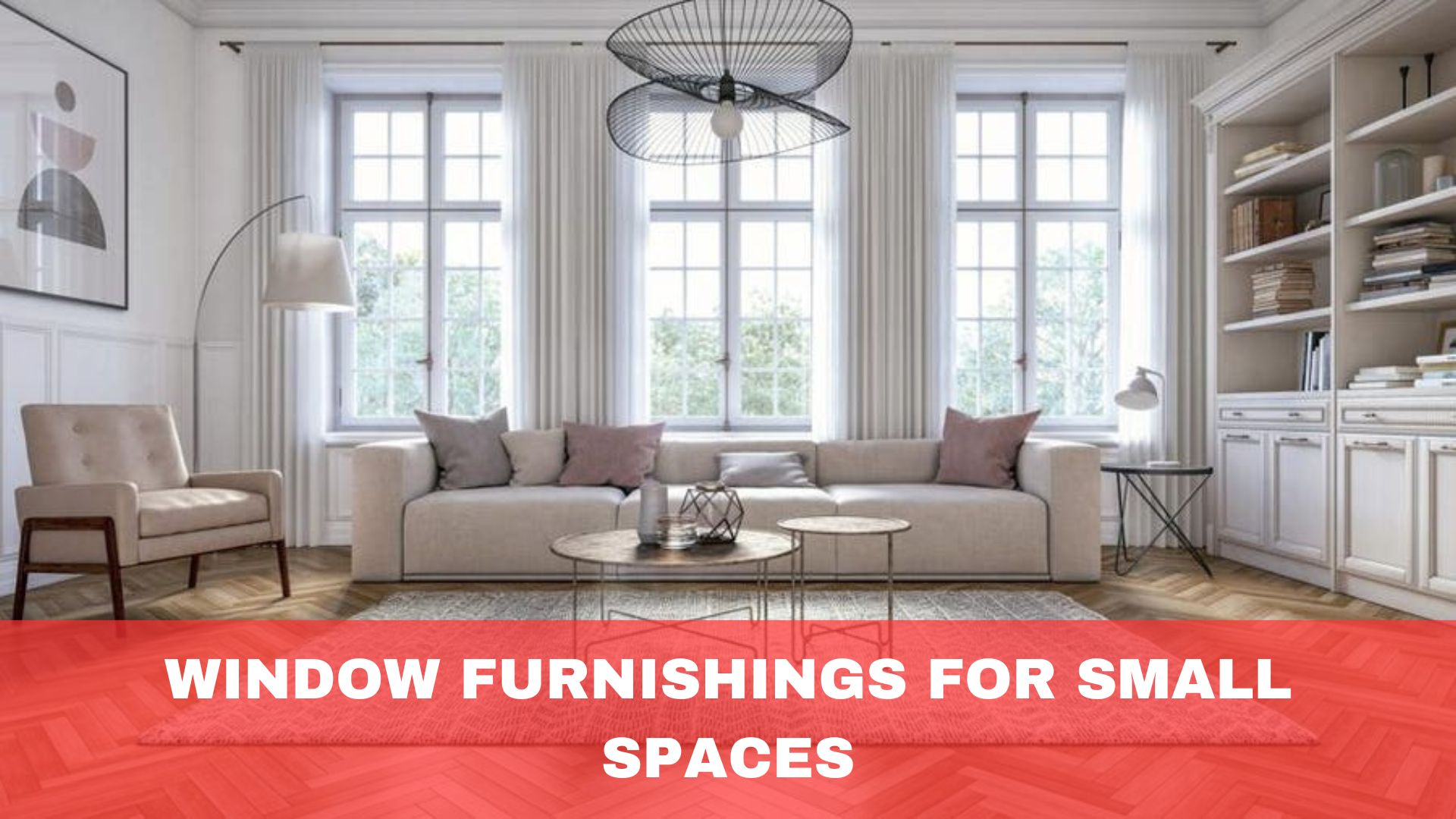Need help finding the perfect window furnishings for your small space?
The wrong choice can make your room feel cramped and dark, exacerbating the limitations of your cosy area.
This article will explore clever window furnishing solutions that enhance your space. These solutions allow natural light to flood in while maintaining privacy and style.
Assessing Your Space and Needs
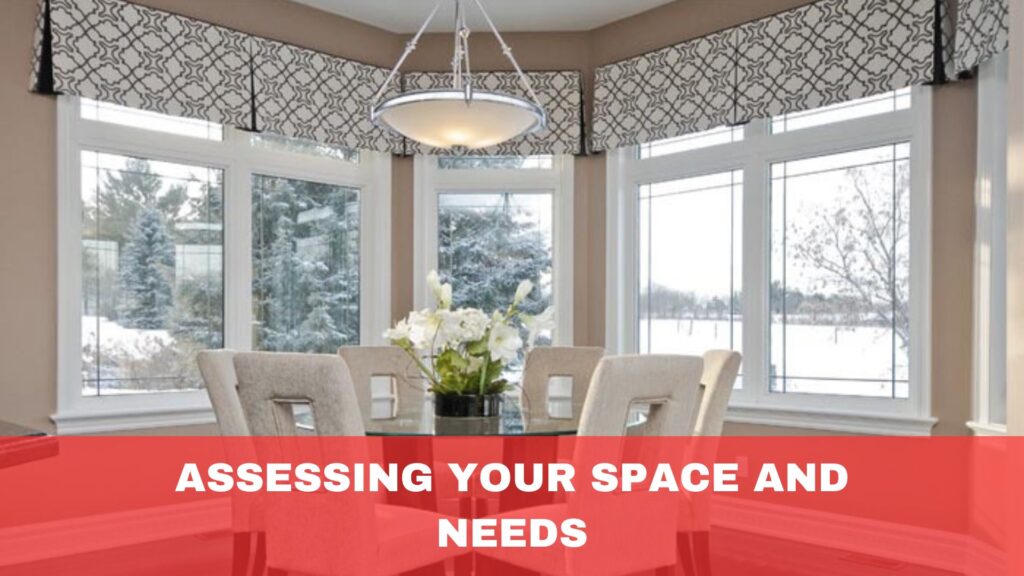
Before diving into window furnishing options, assessing your space and specific needs is crucial.
Start by measuring your windows accurately, considering both width and height. This ensures that your chosen furnishings fit perfectly without overwhelming the room.
Next, evaluate the natural light entering your space. Do you need to maximise sunlight in a dark room or control excess brightness in a sunlit area? Understanding the light dynamics will help you select suitable materials and styles, such as sheer curtains for light enhancement or blackout blinds for light control.
Consider the room’s purpose. For instance, a bedroom may require more privacy and light-blocking features, while a living area might benefit from light-filtering solutions that also offer aesthetic appeal.
Additionally, take note of existing décor and colour schemes. Your window furnishings should complement and enhance your room’s style rather than clash.
Finally, consider functionality. Do you need easy-to-operate blinds, child-safe options, or insulating properties to maintain room temperature? By thoroughly assessing these factors, you can make informed decisions that elevate the functionality and style of your small space.
Choosing the Right Window Furnishings
Below are some of the factors to consider when choosing the right window furnishings;
- Functionality and Style: When selecting window furnishings for small spaces, consider functionality and style. Multifunctional furnishings, such as blinds that offer privacy and light control, are ideal for compact areas. Roman shades and roller blinds are excellent choices because they provide a sleek, unobtrusive look while allowing you to adjust light levels easily. This dual functionality helps to maximise the usability of your window coverings without overwhelming the space.
- Light Colours and Sheer Fabrics: Light colours and sheer fabrics can create the illusion of a larger area. Sheer curtains soften the room’s appearance and let in natural light, making the space brighter and more expansive. If privacy is a concern, layering sheer curtains with blackout blinds can offer a versatile solution, allowing you to control light and privacy as needed.
- Vertical Blinds or Shutters: Vertical blinds or shutters can be particularly effective in small spaces. These furnishings draw the eye upwards, adding height to a room and making the ceiling appear higher. This is especially beneficial in rooms with low ceilings or small windows, as it can enhance the perception of space.
- Decorative Touches: Incorporating decorative touches that match or complement your existing décor can make your room feel more cohesive and expansive. Selecting window furnishings that align with your room’s style ensures that they enhance the overall aesthetic rather than clash with it.
- Maintenance and Ease of Use: Finally, consider the maintenance and ease of use of your chosen window furnishings. It is essential to select materials that are easy to clean and operate, particularly in high-traffic areas. Durable, low-maintenance materials will ensure your window coverings remain functional and attractive. Focusing on these critical factors allows you to choose window furnishings that enhance your small space’s functionality and aesthetic appeal.
- Maximising Natural Light: Make the most of natural light by choosing window treatments that can be fully opened during the day. Lightweight fabrics and streamlined designs help maximise the sunlight entering the room, making it more extensive and inviting. Consider options like sheer curtains that provide privacy without blocking light.
- Space-Saving Designs: For tiny spaces, look for window furnishings that don’t take up much room when open. Roller blinds, for instance, roll up neatly at the top of the window, taking up minimal space. Venetian blinds can also be adjusted to control light without protruding into the room.
- Thermal Insulation: Choose window treatments that offer thermal insulation to maintain a comfortable temperature in your space. Cellular shades, for example, trap air in their honeycomb structure, providing insulation against heat and cold. This can help keep your room warm in winter and cool in summer, enhancing comfort and energy efficiency.
- Custom Fit: Consider having your window furnishings custom-fitted to your windows. Custom-fit treatments match your window size and shape perfectly, enhancing the overall look and functionality. Customisation can also provide options for unique window shapes that standard treatments may not accommodate.
- Motorised Options: For added convenience, consider motorised window furnishings. Motorised blinds and curtains can be operated with a remote control or a smart home system, allowing you to adjust your window treatments effortlessly. This is particularly useful for hard-to-reach windows or those looking to add a touch of modern luxury to their space.
Maximising Natural Light
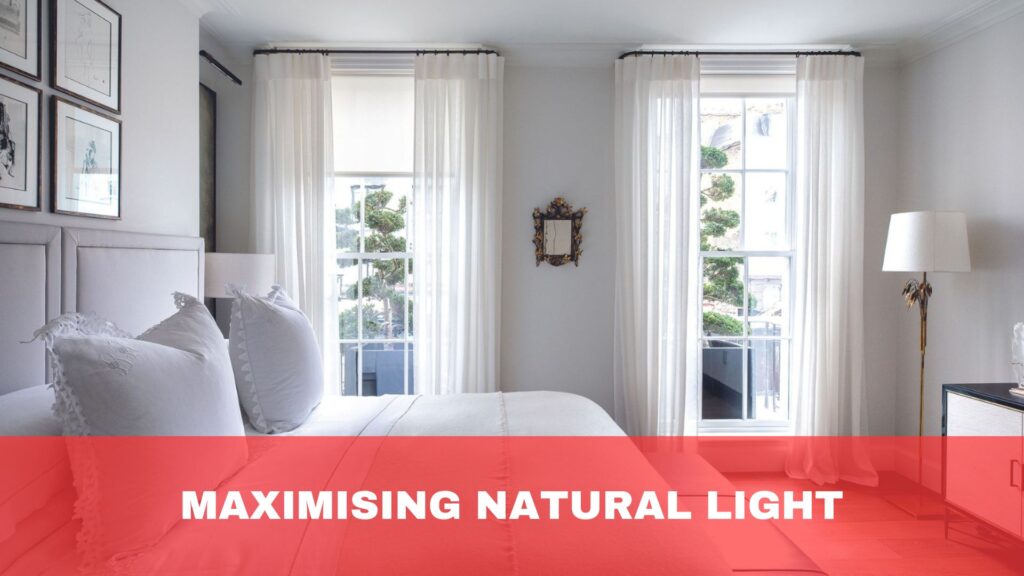
Maximising natural light is essential in small spaces to create a sense of openness and brightness.
Start by selecting lightweight, sheer curtains that allow sunlight to filter through while maintaining privacy. Sheer fabrics are excellent for diffusing light, creating a soft, inviting atmosphere without blocking your view.
Consider using blinds with adjustable slats, such as Venetian or vertical blinds. These allow you to control the light entering the room, directing it upwards or downwards as needed. Top-down, bottom-up shades also provide light control and privacy flexibility.
Keep window treatments simple and minimalistic to avoid obstructing the window space. Opt for roller blinds that roll up neatly or Roman shades that fold compactly at the top. These designs ensure maximum open window exposure, letting in the most light.
Mirrors and reflective surfaces can also help amplify natural light. Position mirrors opposite windows to reflect sunlight more profoundly into the room. Additionally, choose furnishings and décor in light colours and glossy finishes to enhance the brightness.
Space-Saving Installation Tips
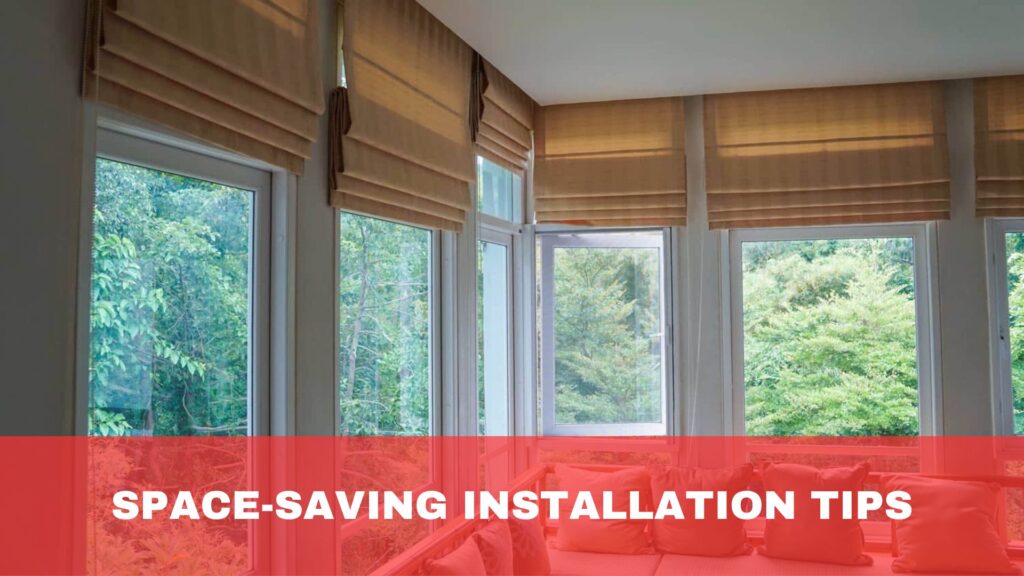
When dealing with small spaces, the installation of window furnishings can significantly impact the overall look and feel of the room.
Start by mounting curtains or blinds close to the ceiling. This technique draws the eye upward, creating an illusion of height and making the room appear more spacious.
Choose slimline or low-profile brackets and hardware to minimise the protrusion from the wall. This keeps the window area neat and maximises the available space. Inside-mounted blinds or shades can also be a great option as they fit within the window frame, reducing bulk and providing a streamlined appearance.
For curtain rods, opt for extendable rods that can be adjusted to fit precisely, avoiding any overhang that might encroach on the room. Consider recessed or hidden track systems for curtains, which keep the hardware out of sight and contribute to a clean, modern look.
Using tiebacks or holdbacks can help keep curtains pulled back during the day, preventing them from taking up valuable space and allowing more light to enter. For small windows, choose furnishings that stack compactly when open, like roller blinds or Roman shades, to keep the window area clear.
Creating the Illusion of Larger Windows
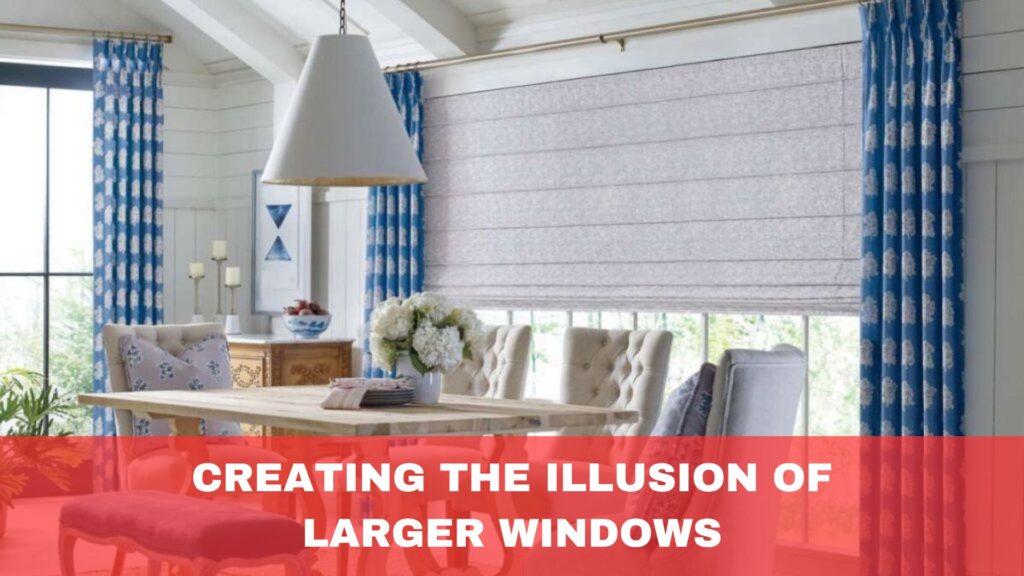
Creating the illusion of more oversized windows can significantly enhance the perception of space in a small room.
Start by extending curtain rods beyond the window frame. Positioning rods several inches wider than the window allows curtains to be drawn fully to the sides, exposing the entire window and making it appear larger.
Hang curtains high above the window, close to the ceiling. This draws the eye upwards, giving the impression of greater height and making the windows—and, by extension, the room—seem taller. Using floor-length curtains adds to this effect, elongating the vertical lines.
Choose light, airy fabrics and neutral colours for your window treatments. Light fabrics like linen or sheer panels let in more natural light and don’t overpower the room. Neutral colours blend seamlessly with the walls, reducing visual clutter and enhancing the sense of openness.
Mirrors placed strategically can also amplify the size of your windows. Positioning a mirror opposite or adjacent to a window reflects natural light and creates the illusion of an additional window.
Avoid heavy or dark window treatments that can dominate the space and make windows feel smaller. Opt for minimalistic designs like roller blinds or Roman shades that fit within the window frame, maintaining a clean, unobstructed look.
Practical Considerations
When choosing window furnishings for small spaces, it’s essential to focus on practicality to ensure they meet your functional needs and enhance your living environment.
Here are several key factors to consider:
- Ease of Operation: Select simple window treatments that open and close quickly, such as roller blinds or cordless shades. These options are user-friendly and safer for homes with children or pets.
- Maintenance and Durability: Opt for materials that are easy to clean and resistant to wear and tear. Fabrics with stain-resistant properties or blinds made from durable materials like aluminium or faux wood can withstand daily use and maintain their appearance over time.
- Light Control and Privacy: Balance natural light with privacy needs. Top-down, bottom-up shades offer versatile light control while maintaining privacy. Consider blackout blinds or lined curtains for rooms requiring complete darkness, such as bedrooms.
- Energy Efficiency: Choose window treatments that provide insulation to keep your space warm in winter and cool in summer. Cellular shades are particularly effective for this purpose, as their honeycomb structure traps air and provides an extra layer of insulation.
- Aesthetic Flexibility: Select window furnishings that complement different decor styles, allowing for easy updates and changes to your interior design. Neutral colours and classic designs are versatile choices that adapt to various themes.
- Space-Saving Design: Opt for window treatments that do not take up much room when open. Inside-mounted blinds or shades fit within the window frame, reducing bulk and providing a streamlined appearance. This is particularly important in small spaces where every inch counts.
- Child Safety: Consider child-safe options such as cordless blinds or motorised shades, which eliminate the risk of entanglement and enhance safety in homes with young children.
- Cost-Effectiveness: Evaluate the cost-effectiveness of different window treatments. Some options offer long-term savings through improved energy efficiency or reduced maintenance costs, making them a more economical choice in the long run.
- Custom Fit: Consider having your window furnishings custom-fitted to your windows. Custom-fit treatments match your window size and shape perfectly, enhancing the overall look and functionality. Customisation can also provide options for unique window shapes that standard treatments may not accommodate.
Conclusion
In conclusion, choosing the right window furnishings can transform your small space, enhancing style and functionality.
Assess your needs, consider practical solutions, and maximise natural light to create a welcoming environment.
Ready to upgrade your space? Explore our expert-recommended window furnishings today and make the most of your windows!

